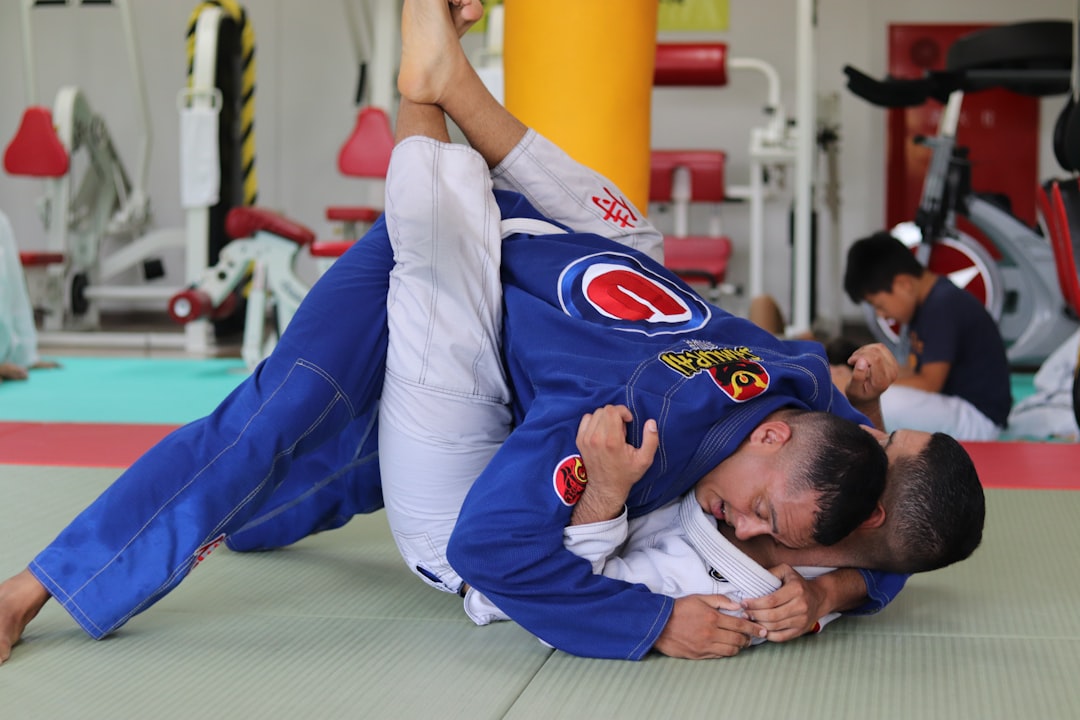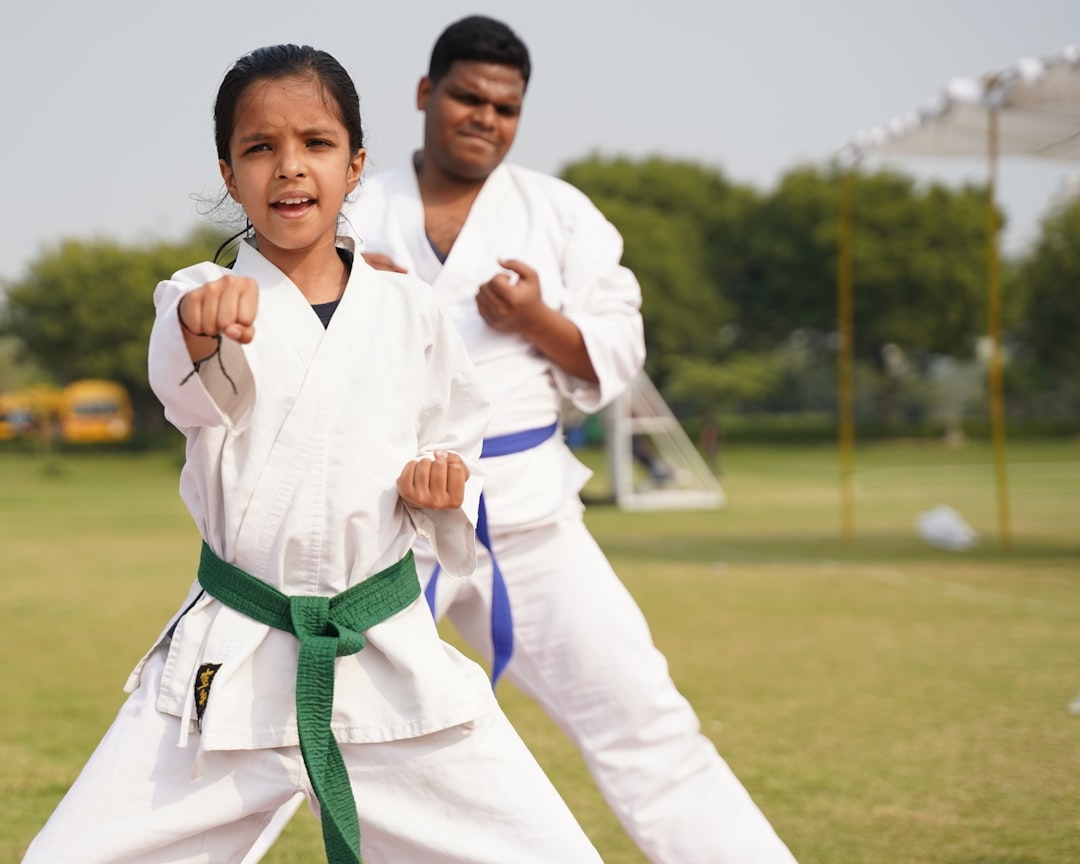The karate outfit, known as keikogi or gi, is a traditional uniform worn by practitioners for both training and competition. It symbolizes respect and solidarity within the martial arts community and is designed for optimal movement and visibility of techniques. Constructed from heavyweight cotton, the gi consists of an upper garment called the uchide (jacket) and trousers named are (trousers), which include belt loops to accommodate the obi, indicating the practitioner's rank. The history of the gi dates back to ancient Okinawa, where it was adapted from a modified Chinese keiko-gi. Today, while maintaining a standardized white color that symbolizes purity, the gi has undergone refinements to cater to the functional needs of karate, with variations allowing for regional differences within styles like Shotokan, Kyokushin, and Goju-ryu. The gi's role extends beyond practical use, serving as a ceremonial attire that encapsulates karate's rich heritage and traditions. Modern interpretations and cultural exchanges have led to the diversification of karate outfits, with specialized uniforms designed for high-performance demands, incorporating reinforced areas and lightweight materials to enhance speed and agility in competition settings. Despite these advancements, the gi has retained its traditional essence and stands as a distinct entity within the broader realm of martial arts attire, reflecting both its historical roots and its adaptation to contemporary practices.
Exploring the essence of martial arts practice, this article sheds light on a fundamental aspect often overlooked: the karate uniform, or ‘gi.’ Delving into its origins and significance, we trace the historical evolution of these garments, examining their transformation over time. From traditional white belts to contemporary adaptations, understand how each element reflects the discipline’s rich heritage and the wearer’s commitment to the art. The term ‘karate outfit name’ will guide us through the various titles these uniforms have carried throughout history and into modern-day practices, highlighting their role as more than mere attire—a symbol of respect, tradition, and personal achievement in the world of karate.
- Unveiling the Traditional Attire: The Significance of the Karate Uniform
- Historical Evolution and Styles of Karate Gis
- Modern Interpretations: Today's Karate Outfits and Their Evolving Names
Unveiling the Traditional Attire: The Significance of the Karate Uniform

When engaging in the disciplined practice of karate, the practitioner dons a distinctive uniform known as a “keikogi” or “gi.” This traditional attire is not merely a garment but a symbol of respect and unity among martial artists. The keikogi’s design facilitates ease of movement and allows for an unobstructed view of the practitioner’s technique, which is crucial during training and competition. Crafted with a heavyweight cotton fabric, the top, called a “uchide” or jacket, and the bottom, referred to as “are” or trousers, are designed to be both durable and breathable. The uniform also features belt loops for the obi, or belt, which is another significant aspect of a karate practitioner’s attire, indicating their rank. Are the differences in design among various martial arts significant? Absolutely, as each style’s uniform is tailored to its specific needs, but the keikogi remains central to the identity of a karateka. The uniform not only signifies the wearer’s dedication to the art of karate but also serves as a canvas for belts and patches that denote progress, achievements, and affiliations within the martial arts community.
Historical Evolution and Styles of Karate Gis

Karate practitioners around the world wear a traditional uniform known as a Gi, which serves both functional and ceremonial purposes. The evolution of the karate Gi has historical roots that can be traced back to ancient Okinawa, where its predecessor was worn by martial artists for practice and demonstration. Originally, these outfits were adapted from the Chinese keiko-gi, or training jacket, which was itself a modified version of a common peasant garment. Over time, the karate Gi has undergone changes to suit the needs of the martial art, including adjustments in cut, fabric, and fit to enhance mobility while allowing for an unobstructed view of the practitioner’s movements.
Today, the karate Gi is a standardized garment, with its design relatively consistent across various styles of karate such as Shotokan, Kyokushin, Goju-ryu, and others. The traditional Gi consists of a jacket and trousers made of cotton or hemp, typically white in color, symbolizing purity and neutrality on the mat. The exact specifications can vary slightly depending on the organization or country; for instance, the length of the sleeves and skirt may differ. Additionally, the string tie at the waist, obi, is often required to be tied only once during competition, with a special knot signifying the athlete’s readiness for assessment. Whether practicing in a dojo or competing in a tournament, the karate Gi remains an integral part of the martial art, embodying its rich heritage and unifying practitioners worldwide.
Modern Interpretations: Today's Karate Outfits and Their Evolving Names

Modern interpretations have significantly influenced the naming and design of karate outfits, which are traditionally referred to as “keikogi” in Japanese. While the keikogi remains the standard garb for most karateka, variations and adaptations have led to the emergence of different names for karate uniforms. Are today’s karate outfits merely a continuation of traditional wear, or have they evolved into something distinct? The answer lies in the way modern materials and cultural exchanges have reshaped the karate outfit over time. For instance, some practitioners opt for “gi” which is a more generic term used across various martial arts, emphasizing the universal aspects of training. On the other hand, specialized karate outfits, often designed for competitions or specific styles like Shotokan or Kyokushin, may carry unique names that reflect their purpose and design. These specialized uniforms might include features such as reinforced patches or lightweight materials tailored for speed and agility, answering to the dynamic nature of contemporary karate practice and competition.
In our exploration, we’ve delved into the rich tapestry of karate’s traditional attire, revealing the significance and evolution of the karate gi. From its historical origins to contemporary adaptations, the karate uniform has undergone transformations while retaining its core identity. Understanding the name of a karate outfit—a term that encompasses both tradition and function—offers insight into the discipline’s heritage and modern practice. As martial artists continue to honor and reinterpret these customs, the karate outfit name remains a testament to the sport’s origins and its adaptability across generations. Whether in dojo or competition, the uniform stands as a symbol of respect, skill, and dedication, embodying the essence of karate itself.
